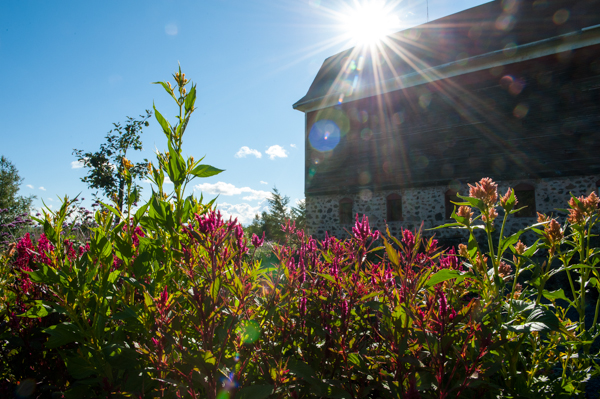My husband, Ted, asked me if I wanted to go for a ride. Now, if he posed that question to George, our yellow Lab, it would mean a trip to the beach was in order but since it was a September afternoon, I knew it meant a drive down Echo Valley Road scouting for a tree to dispatch into firewood for the winter. Living in Bayfield has taught me the importance of moving with the cadence of the natural world and harvesting, whether it’s firewood from the forest, vegetables from the garden or apples from the orchard, is a cherished ritual of autumn. It is work that’s good for the spirit— preserving the bounty of summer for the snow-blanketed days ahead.
En route to our firewood safari, untended apple trees along the road caught my eye— the last witnesses to homesteads long since abandoned. I wondered about the stories that unfolded in those overgrown fields and under the fruit-laden trees that are remnants of families who chose to settle in this beautiful place. Bayfield, by virtue of its location on the peninsula, is a microclimate that’s particularly well-suited for agriculture. Jesuits planted cherry trees on Madeline Island in the 18th century, lighthouse keeper Roswell Pendergast started a nursery on Michigan Island in 1870 that supplied apple, cherry, plum, peach and pear trees to farmers in the region and William Knight planted the first commercial apple and cherry orchard in 1905. The apple trees I saw on the road, and the apple orchards operating today, are a testament to the men and women who understood the intricate relationship between stewardship and a bountiful harvest.
Ellen Kwiatkoski and Eric Carlson, owners of Blue Vista Farm, view themselves as caretakers of a remarkable farm filled with raspberries, blueberries and 1,500 apple trees. They practice the land ethic used by many of the farmers who continue to work the land around Bayfield— true sustainability means maintaining the delicate balance between the harvest and the subsequent restoration of the land, trees, soil and plants. At its heart, stewardship means understanding we, as humans, are transitory and it’s what we plant, nurture and preserve that’s a testament to what we value.
When we live in tandem with the earth and its rhythms, life becomes more predictable. Winter follows autumn, geese move from north to south and back again every year, trees sprout, grow and die in one patch of soil in the forest, the sun rises and sets on the horizon every single day and the harvest comes in after a season of expansion and growth. Harvest is a time to suspend the busy and chaotic business of living and offer thanks for the sheer abundance we are gifted with every year. And to remember that while the harvest is freely given, the essence of its generosity is inexplicably tied to our ability and desire to return the favor— in all of our actions and decisions.
Is a yard full of freshly split firewood or a pantry full of preserved beans, tomatoes and apples enough to show my appreciation for the natural world? It’s a step in the right direction, that’s for sure. The act of gathering firewood, apples or tomatoes goes hand in hand with restoration. Nature, in order to continue to provide, must be in balance and just as I benefit from the harvest, I must contribute to the health of my eco-system. When I prepare food that’s grown with integrity, fill my wood stove with logs from the forests near my home or spend time around a table heavy with the largess of gardens and orchards— I’m participating in the age-old ritual of celebrating my community, honoring the harvest and the beautiful place I call home. And that’s a good place to start.
Roasted Apple & Chipotle Butter
2 cups apple cider 7 tablespoons brown sugar 1 ½ tablespoon freshly squeezed lemon juice 5 tablespoons butter 3 pounds Cortland or Jonafree apples (or your favorite sweet/tart apple) 3 – 5 chipotle peppers in adobo, minced (depending on your heat tolerance) 1 teaspoon cinnamon ¼ teaspoon nutmeg ¼ teaspoon kosher salt 1 large shallot, chopped (about 1/3 cup) 1 cup dried apple slices, chopped 4 tablespoons Calvados or apple brandy
Preparation In a medium skillet, heat 1 tablespoon of butter over medium heat. Place the chopped shallot in the pan, lower the heat and sauté for about 10 minutes. Add the chopped dried apple and cook for 2 – 3 minutes, stirring occassionally. Add the Calvados and set aside.
Preheat oven to 375 degrees. Cut the apples into eighths and place in a large roasting pan (do not peel or remove the seeds). Pour the lemon juice, 1 cup of the apple cider, 4 tablespoons of butter and the sugar on top. Toss to combine and place in the oven for about 45 minutes or until the apples are very soft and lightly browned. Remove the pan from the oven, pour the additional 1 cup of cider over the top, stirring to remove any caramelized apple bits from the pan.
Transfer the apples and liquid to a large bowl and mash the pieces with a potato masher (or fork) until it looks saucy. Run the mixture through a food mill to remove the seeds and skins. Add the reserved apple/shallot mixture, cinnamon, nutmeg and minced chipotles. If the butter is too runny, transfer to a saucepan and cook over low heat, stirring occasionally, on the stovetop until it’s the consistency you prefer. If you prefer a smoother texture, once the butter is cooled, you can blend it in a food processor or blender.
Store in an airtight container in the refrigerator for up to a week. Makes 3 cups.



